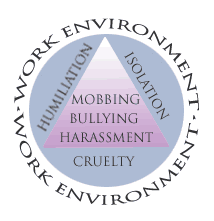The following research refers frequently to “MOBBING, Emotional Abuse in the American Workplace”:
- James Hillard, MD, refers to Mobbing, Emotional Abuse in the American Workplace throughout his article Workplace mobbing: Are they really out to get your patient? Published in Current Psychiatry, April 2009, pages 45-51.
- Linda Zarrin Shallcross, The Pecking Order: Workplace Mobbing in the Public Sector, M.A. Thesis, Faculty of Commerce and Management, Griffith University, Australia, November 2003.
The study cited below operationalizes the concept of first, second and third degree mobbing/bullying that was first introduced in the book “MOBBING, Emotional Abuse in the American Workplace.”
- Pamela Lutgen-Sandvik et al., Workplace Bullying in the United States, Incidence, Comparison to International Research and a Delineation of Bullying “Degree”, The Hugh Downs School of Human Communication, Arizona State University. Conference Paper, 2004.
Further references to the book MOBBING are mentioned in:
- Mobbing: Causes, Consequences, and Solutions by Maureeen Duffy and Len Sperry; Oxford University Press, published in 2012, refers to our popular “MOBBING, Emotional Abuse in the American Workplace” on several pages.
- Making Work Work For the Highly Sensitive Person
by Barrie Jaeger, Ph.D. – McGraw-Hill, 2003 - The Trial, Degradation and Dismissal of a Professor: Administrative Mobbing in Academe by Prof. Ken Westhues. Prof. Ken Westhues’ new book on Administrative Mobbing in Academia. His book deals meticulously with a case study of intolerance and exclusion. It is the story of Herbert Richardson, Professor of Religious Studies at St. Michael’s College, University of Toronto, who was officially dismissed and publicly disgraced in 1994. Published by The Edwin Mellen Press, 2003.
- A reference to Mobbing, Emotional Abuse in the American Workplace can even be found in a novel that deals with a college mobbing:The Teasdale Primer (for MBAs)
by Darian Land
Writer’s Club Press, 2003
(ISBN 0-595-26825-0)





